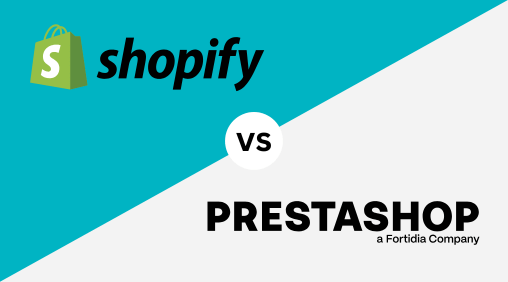If you want to start your own online store today, you quickly face the question: PrestaShop or Shopify – which e-commerce platform is the better choice? Both are among the most well-known e-commerce platforms worldwide and promise to let you sell your products online with ease.
However, their approaches are fundamentally different: Shopify is a cloud-based “all-in-one” solution, while PrestaShop, as an open-source system, offers maximum freedom.
For you, this means: depending on whether you’re looking for flexibility or simplicity, the decision can turn out very differently. You might be wondering: Is PrestaShop better because you have full control over design, modules, and customizations? Or is Shopify the smarter choice because you can get started immediately without technical know-how and don’t have to worry about hosting, updates, and security?
That’s exactly where this article comes in. We compare the two, take a look at features, costs, usability, and typical use cases. This will help you find out which shop system is perfect for your business—whether you’re just about to launch an online store or have been active in e-commerce for some time and are looking for a better solution.
PrestaShop vs Shopify at a glance: costs, usability & design
If you’re wondering which shop system suits you best, you first need to understand the basics. Both systems follow two completely different approaches, and this strongly influences how you build and operate your store.
PrestaShop: Open source and full control
This system was developed in France in 2007 and is now one of the most popular online store solutions in Europe. The software is open source and free in its basic version. You download it, install it with your hosting provider, and gain full control over your shop.
This freedom comes with many advantages: you can choose from thousands of themes, install modules, and customize almost every detail. Whether it’s special payment methods, marketing features, or multilingual support—almost anything is possible with this system.
The downside: you need technical knowledge or support to properly manage setup, updates, and hosting. However, if you enjoy working with technology or value deep customization, this open-source shop system is an exciting solution.
Shopify: Simplicity and instant launch
Shopify is the direct opposite. Instead of installation and hosting, you simply take out a subscription and log in. Everything runs as a SaaS solution in the cloud—from updates and security to hosting. This allows you to bring your store live in a very short time.
The system is extremely user-friendly: during setup, a wizard guides you through all the steps—adding products, activating payments, setting up shipping. The dashboard is clearly structured, and with just a few clicks you can add additional features via the App Store, such as Shopify Plus apps.
The downside: many extensions come with monthly fees, so costs can increase over time.

Cost comparison
When it comes to budget, there are major differences between the two shop systems.
Summary of key points:
|
Criteria |
Prestashop |
Shopify |
|
Basic costs |
Free software |
from approx. 30 € per month |
|
Hosting & Domain |
choose & pay yourself |
including |
|
often required separately |
including |
|
|
Extensions / Apps |
mostly one-time purchases, flexible |
many in subscription model, ongoing costs |
|
Transaction fees |
depending on payment modules |
additional fees without Shopify Payments |
Conclusion: At first glance, the open-source system appears cheaper because you only pay for the components you actually need. In return, you have to take care of hosting and technical aspects. The SaaS solution is more expensive but offers predictable monthly costs and an all-inclusive, worry-free package.
Usability, design & extensions compared
These points show at a glance how both systems differ in terms of usability, layout, and additional features:
|
Criteria |
Prestashop |
Shopify |
|
User-friendliness |
Installation and setup require expertise. High flexibility, but a steep learning curve. |
Ready to go with guided setup. Very beginner-friendly, no technical knowledge required. |
|
Design & Themes |
Large selection of themes and templates , highly customizable. |
Less choice, but high-quality themes , mobile optimized and easy to edit. |
|
Extensions & Apps |
Thousands of modules, often paid for once, very flexible, technical knowledge helpful. |
App Store , with easy installation, mostly in a subscription model with ongoing costs. |
Conclusion: With the open-source solution, you get maximum flexibility if you’re willing to invest time in technology and customization. With the SaaS solution, you can start immediately with minimal effort, but with ongoing costs due to apps.
Features & functionality compared
When comparing both shop systems, specific features are crucial. After all, you want not just a visually appealing store, but also everything needed for products, marketing, payments, and growth.
The following table summarizes the main differences:
|
category |
Prestashop |
Shopify |
|
Product management |
Unlimited products & variants, complex catalogs, digital products, flexible data fields. |
Easy management, but limits apply to lower-priced plans (e.g., variants). Ideal for small to medium-sized product ranges. |
|
Internationalization & Multilingualism |
Multilingualism and multi-shop functionality are directly integrated. Very powerful for international projects. |
Multilingualism via apps, less convenient with many languages/markets. |
|
SEO & Marketing |
In-depth SEO adjustments (meta, URLs, structure). Numerous apps for cross-selling, newsletters, etc. |
Integrated marketing tools, social media, and Google Shopping integration. Ideal for rapid reach growth. |
|
Payments & Shipping |
Wide selection of payment modules; setup and costs vary. Shipping must be configured manually. |
Shopify Payments ready to use (credit card, PayPal, etc.). Shipping solutions integrated. |
|
performance |
Dependent on hosting, can be optimized with technology and tutorials. Responsibility lies with you. |
Cloud-based & automatically optimized, stable & performant without additional effort. |
|
Scalability |
Almost infinitely expandable, from small to huge shops. Requires greater technical effort. |
Automatically scalable, upgrade to Shopify Plus for enterprise-level functionality. |
Conclusion: The open-source system gives you full control and maximum flexibility—perfect if you have technical expertise or work with developers. The SaaS solution stands out with ease of use, worry-free growth, and instant readiness, ideal if you want to focus on marketing and sales.

Security & Updates
Security is critical in e-commerce. Customers expect their personal data, passwords, and payments to be protected at all times. Regular updates are also essential to keep your store stable and free from vulnerabilities.
Both systems take very different approaches:
- Prestashop:
- You are responsible for security, updates, and backups.
- Hosting, patches, and maintenance must be organized manually.
- Support comes from community posts, tutorials, modules, or agencies.
Advantage: You can define your own security level and adapt it to individual requirements—especially valuable for larger shops with special processes.
Disadvantage: Missed or poorly installed updates can lead to downtime or security risks. Many merchants therefore rely on agencies for professional maintenance.
- Shopify:
- Security and updates run automatically in the background.
- SSL certificate, PCI-DSS compliant payments and server protection are fully integrated.
- New features, bug fixes , and patches are applied without your involvement.
The advantage: You get a stable, modern system that is always up to date, saving significant time and costs—especially for small teams without an IT department.
Disadvantage: You depend on Shopify’s security standards and have limited ability to define custom rules, which is usually sufficient for most merchants.
Conclusion: Prestashop offers maximum control but requires technical expertise or external support. Shopify is the true “worry-free package,” letting you focus entirely on products, marketing, and growth.
Support & community compared
At some point, you’ll need help—whether it’s a technical issue, a new feature, or a sudden problem during peak season.
The two systems differ significantly in how support is provided:
- Prestashop:
- No central 24/7 support, but a large community with forums, Facebook groups, blogs, and GitHub issues.
- Many tutorials and the user guide give you step-by-step help.
- More complex problems such as module conflicts or migrations are often solved by specialized agencies, who, for a fee, address your store individually.
- The focus is clearly on technical topics such as hosting, module development or integration.
- Shopify:
- Offers direct 24/7 support via chat, email, or phone, depending on your plan, especially valuable when you need answers quickly.
- Additionally, you get access to a help center with tutorials , blog articles , video lessons and an active community.
- App providers in the App Store often have their own support, so you can get quick help with extensions.
- Discussions in the community focus more on tips, marketing, conversion optimization, and strategies to increase your sales.
Conclusion: Which shop system suits you better largely depends on your expectations regarding support. PrestaShop relies on community knowledge and agencies, which gives you a lot of flexibility but requires personal initiative. Shopify, on the other hand, offers direct 24/7 support, complemented by strong documentation and app providers who can help you quickly.
This is a real advantage, especially for smaller teams without their own IT department. If you choose Shopify, you’ll find more tips on conversion rate optimization in our article: Shopify Conversion Rate.
Target groups & use cases
Not every shop system fits every business model. To make the right decision, it’s worth looking at who PrestaShop and Shopify are best suited for. In the end, you’re not just choosing a shop system—you’re choosing a way of working.
- PrestaShop is particularly suitable if you need maximum flexibility, plan multiple shops or highly customized features, and are willing to deal with technical aspects. It’s typically used by medium-sized to large shops that aim for long-term growth and have a team or solid technical know-how.
A typical example would be an international fashion retailer that requires multiple language versions and complex ERP integrations—this is where the open-source solution truly shows its strengths.
- Shopify, on the other hand, is perfect if you want to get started quickly. Log in, choose a theme, set up payments, and your store is online. This makes the system especially suitable for founders, small businesses, or solo entrepreneurs who want to sell products with minimal effort.
A typical example: a startup selling handmade accessories directly via Instagram and wanting to launch an online store within just a few days. Thanks to Shopify Plus, you can later scale to enterprise level without having to switch platforms.
If you’re wondering where the differences between the plans lie, you can find more details in our comparison Shopify Advanced vs Shopify Plus.
In short: the open-source solution stands for complete freedom and greater responsibility—ideal for individualists and larger projects. The SaaS solution offers maximum simplicity and clear support, making it perfect for quick wins and beginners.

Pros and cons of both shop systems
After taking a detailed look at both systems, it’s time for a clear comparison. This isn’t about finding the single “best” system, but about determining which one better fits your specific requirements.
The overview shows you the most important criteria:
|
Prestashop |
Shopify |
|
|
Cost |
Basic version free, costs for hosting, modules & themes (often one-time payments). |
Monthly fees start at approximately €30, with additional charges for apps and transactions. |
|
simplicity |
Demanding, setup & maintenance require technical knowledge. |
Very simple, ready to use, with guided setup. |
|
flexibility |
Very high, full adaptability through customization. |
Customizations via apps & themes, deeper changes possible with coding. |
|
Design & Themes |
Large selection of themes, highly customizable. |
Fewer choices, but high-quality, mobile-optimized themes. |
|
Apps & Extensions |
Thousands of modules, often purchased once, very flexible. |
Huge app store, easy installation, mostly subscription-based. |
|
internationalization |
Multishop & multilingualism directly integrated. |
Multilingualism possible via apps, more limited than with Prestashop. |
|
Performance & Scalability |
Depends on the hosting, technically optimizable, but personal responsibility. |
Cloud-based, automatically performant, upgrade to Shopify Plus possible. |
|
Security & Updates |
You are responsible for patches, backups & updates. |
Security & updates are fully taken care of. |
|
Support & Community |
Huge community, lots of tutorials, professional help through agencies. |
24/7 support, extensive tutorials, active community with a focus on marketing & sales. |
|
Target group |
Medium to large shops with individual requirements & technical know-how. |
Founders, beginners & growing brands who want to start without technology. |
The table shows that PrestaShop is the right choice if you want maximum flexibility and full control over your store. It’s ideal for larger projects, custom solutions, and merchants who have technical expertise or access to a development team.
Shopify, on the other hand, stands out for its simplicity, predictable costs, and all-in-one, worry-free package. Hosting, security, and support are handled automatically, allowing you to focus on marketing and sales. This makes the SaaS solution especially attractive for founders, small businesses, and growing brands that want to launch and scale online with minimal effort.

Conclusion: Prestashop vs Shopify - which shop system is right for you?
More shop system comparisons
After this comparison, you may still not be entirely sure whether either of the two systems is truly the best fit for your business. After all, there are other platforms that can also be appealing depending on your target audience, budget, and technical setup.
Here you’ll find more detailed comparisons:
- WooCommerce vs Shopify : ideal if you already use WordPress and are wondering if WooCommerce is enough or if switching to Shopify will bring more benefits.
- Shopware vs Shopify : particularly interesting for retailers in German-speaking countries who choose between a strong local solution and an international platform.
- Magento vs Shopify : a comparison for companies with complex requirements that are balancing open source freedom with SaaS convenience.
- BigCommerce vs Shopify : an exciting international alternative that can also be attractive in some scenarios.
- Shopify vs Etsy : perfect for creatives and smaller retailers who currently sell on Etsy and are looking for more independence.
These articles will give you an even more comprehensive overview and help you ensure that you ultimately find the best shop system for your business .








